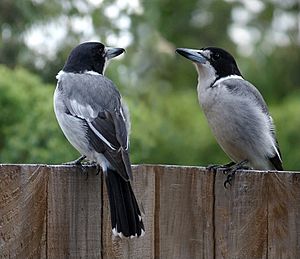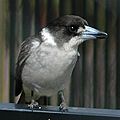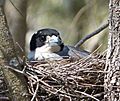Grey butcherbird facts for kids
Quick facts for kids Grey Butcherbird |
|
|---|---|
 |
|
| Two perching on a garden fence in Brisbane, Australia | |
| Conservation status | |
| Scientific classification | |
| Genus: |
Cracticus
|
| Species: |
torquatus
|
The grey butcherbird (Cracticus torquatus) is a special bird that lives only in Australia. You can find it in many different places, like dry areas, semi-dry areas, and places with mild weather. It lives across southern Australia, but not in the hot deserts in the middle or the monsoon areas up north.
This bird is famous for its amazing, "rollicking" song! It's also doing well living in cities and can be seen in the suburbs of places like Brisbane, Melbourne, and Sydney. Grey butcherbirds hunt and eat small animals, including other birds.
Other birds that are part of the same family as the grey butcherbird include the Australian magpie, currawongs, woodswallows, and other types of butcherbirds.
Contents
About the Grey Butcherbird
What's in a Name?
The grey butcherbird was first officially described in 1801 by an English bird expert named John Latham. He gave it the scientific name Lanius torquatus.
Scientists group animals that are similar. The grey butcherbird has some close relatives, like the silver-backed butcherbird (Cracticus argenteus) and the black-backed butcherbird (Cracticus mentalis). The silver-backed butcherbird, found in places like Arnhem Land and northwestern Australia, was once thought to be just a type of grey butcherbird. But now, scientists say it's its own separate species!
Different Types of Grey Butcherbirds
There are three main types, or subspecies, of the grey butcherbird:
- C. t. torquatus: This type lives in southeastern Australia.
- C. t. cinereus: This type is found only on the island of Tasmania.
- C. t. leucopterus: This type is widespread and lives all the way from the west coast to the east coast of Australia.
Appearance and Size
The grey butcherbird is a small bird with grey, black, and white feathers. It usually weighs about 90 grams (3.2 ounces). Its body is about 27–30 cm (10.6-11.8 inches) long, and its wings can spread out to 37–43 cm (14.6-16.9 inches). It's a bit smaller than the Pied Butcherbird.
Adult grey butcherbirds have a black head, back, and sides. Their chin and throat are white, and this white color goes up to the back of their neck. Their upper body is mostly dark grey with thin white stripes near the base of their tail. The top of their tail is black with small white tips. Their wings are grey with large white areas underneath. The tip of their beak has a slight hook that points downwards.
Both male and female grey butcherbirds look very similar, but the female is usually a little smaller.
Young Butcherbirds
Young grey butcherbirds, called juveniles, look a bit different from the adults. Their head is dark brown instead of black, with fine streaks on their forehead and ears. They have white spots near their eyes and beak, and their chin and throat are off-white. Their upper body is dark brown with streaks, and the base of their tail is also brownish. Young birds have completely dark grey beaks, and the hook at the tip might not be very clear. People sometimes mistake young grey butcherbirds for small kingfishers.
Amazing Song
All the grey butcherbirds in a family group sing together to protect their territory. Their song is loud and "rollicking," meaning it's lively and musical, but can also have some rougher sounds. Sometimes, just one bird sings, but often two or more birds sing a duet or a group song. In some duets, it's hard to tell that two birds are singing because they take turns so quickly.
Most songs have different parts, and the birds sing these parts one after another. Sometimes their songs overlap a little. Some of their songs can last for up to 15 minutes! While they are singing, they usually don't interact with other butcherbird groups.
Reproduction and Home
Grey butcherbirds usually have one breeding season from July to January. Both the male and female birds protect their home and nest all year round. The female bird sits on the eggs to keep them warm. Once the chicks hatch, both parents feed them until they are old enough to fly.
Their nest is shaped like a shallow bowl and is made from sticks and twigs. They line the nest with soft materials like grasses. Nests are usually built within 10 m (32.8 ft) off the ground.
You can find grey butcherbirds in many different places. They live in eucalyptus forests, woodlands, shrublands, rainforests, and even in cities and towns. They seem to prefer denser forests when they live inland.
Behavior and Diet
Grey butcherbirds eat many different things. They mainly eat small spineless creatures like insects. They also eat small animals with backbones, including other small birds, their baby chicks, and lizards. Sometimes, they even eat fruit and small seeds.
These clever birds sometimes store extra food in the fork of a tree branch to eat later. If a piece of food is too big to eat all at once, they might also stick it onto something sharp or hide it for later.
Grey butcherbirds often sit on branches and wait patiently for their prey. When they spot something, they quickly pounce on it from above. They can also catch small birds and insects while flying. They often sneak up on birds that are looking for food on the ground, usually attacking them from behind. Grey butcherbirds might hunt alone, in pairs, or in small family groups.
Gallery
See also
 In Spanish: Vedugo acollarado para niños
In Spanish: Vedugo acollarado para niños









